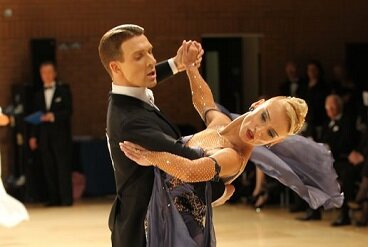The 4 Tango Reverse Turns 
7 June 2017
Reverse Turns are some of the most frequently used figures in all of Tango, found in the routines of new dancers and World Champions alike, so it is important to have a thorough understanding of them from the beginning. This article will discuss the similarities and differences between the four Reverse Turns of Tango, and a little bit of history as well.
Principles for All Reverse Turns
N.B. The Fallaway Reverse Turn is not included, as it is imported from the other dances into Tango.
• Commences with Man facing DC in Closed Position
• Ends with Man facing DW in Closed Position
• Makes 3/4 to L overall
• Commences with Man's LF, Lady's RF
• Step 1 in CBMP
• May end with either a Closed or Open Finish
• All Reverse Turns (with the exception of the Progressive Side Step Reverse Turns) consist of six steps, counted QQSQQS
The reason step 1 of the Reverse Turn is always taken in CBMP is because it is danced as a LF Tango Walk.
Basic Reverse Turn (Gold)
If you aren't familiar with the figure, you can read about it here.
This is the simplest of all the Reverse Turns; in fact, the first three steps are almost identical to the Reverse Turn in Viennese Waltz. The last three steps, however, differ from Viennese Waltz in that both the Man and the Lady close their feet, which is called a Closed Finish. The reason the Lady does not have to cross here as she does in Viennese Waltz is because only 3/4 of a turn needs to be made, as opposed to a full turn made in Viennese Waltz.
Although the basic timing for this figure is QQSQQS, advanced dancers will often modify this figure to be danced either QQ&QQS or even QQ&QQ& (the latter timing is not allowed in the syllabus).
Open Reverse Turn, Lady Outside (PreBronze)
If you aren't familiar with the figure, you can read about it here.
This is the Reverse Turn most people learn first, use most often, and is often referred to simply as the Open Reverse Turn. It is also the most difficult, as it is typically danced using Outside Partner Position. Traditionally, this Reverse Turn ends with an Open Finish, and in that way it is consistent with the Basic Reverse Turn. In the Basic Reverse Turn, on step 3 the Lady closes her feet and the Man crosses, and at the end both close their feet (Closed Finish). Here, on step 3 a step is taken OP and the feet are open, and that is how this figure is traditionally ended.
Even with these two endings available, it is commoner to end with a Closed Finish. Even in 1932 Victor Silvester wrote, "the figure is usually terminated after No. 3, by going straight into 4, 5, 6 of the Basic Reverse Turn."
Open Reverse Turn, Lady in Line (Bronze)
Although most acknowledge this to be a variation of the Open Reverse Turn, Lady Outside, some have decided to classify it as an entirely different figure. This Reverse Turn is almost the same as the Open Reverse Turn, Lady Outside, except for one key difference: instead of dancing in Outside Partner Position, Closed Position is used. This means that on step 3, the Lady will step forward as normal, and also that traditionally this figure is ended with the Man stepping forward in Closed Position as well, an ending which has been abandoned and is no longer used anywhere in Tango. Today, as with all Reverse Turns, an Open or Closed Finish may be used.
Progressive Side Step Reverse Turn (Bronze)
If you aren't familiar with this figure, you can read about it here.
Perhaps the most peculiar and obscure of the Reverse Turns, this is the only one for which the beats are not counted QQSQQS, and which contains more than six steps. This Reverse Turn is a sort of melange of an overturned Progressive Side Step, LF Rock, and can even end using an Open or Closed Finish. It is particularly useful when substituted for other Reverse Turns as a dodger, because whereas the others progress strongly down the floor, this one turns around, rocks in place, and finishes at the same alignment.